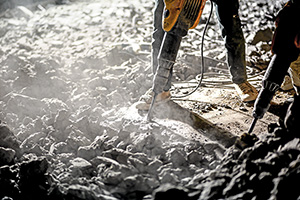Hand-arm vibration syndrome (HAVS) in simple terms is a name for a group of conditions caused by the continuous use of hand-held power tool and industrial equipment. The intense vibrations from this machinery can cause serious and irreversible damage to nerves, bones, tendons, muscles, and blood vessels. The 2 main conditions caused are known as carpel tunnel syndrome (CTS) and vibration white finger (VWF).
If HAVS is contracted it can lead to employees having to take time off work as sick leave or even leave employment because of the pain, tingling or loss of feeling or strength. Industries where there is a higher risk of HAVS include: foundries, heavy steel fabrication and construction.

Latest figures from the HSE show that occurrences of both CTS and VWF are in decline, with only 205 New cases of Hand-Arm Vibration Syndrome in 2019.
This is in part due to the introduction of the Control of Vibration at Work Regulations 2005, which sets vibration exposure limits, along with greater awareness of HAVS and how to prevent it.
REDUCING THE RISK OF HAVS
The first line of defence against HAVS is to completely avoid having to physically handle equipment that vibrates powerfully. However, in many cases it’s not possible, meaning workers and their managers need to take mitigating steps. Cost effective and simple measures include:
- Using tools with reduced vibration
- Taking regular breaks
- Limiting length of time using the tools
- Keeping the body warm if working in cold conditions to improve blood circulation and reduce damage
CAN SAFETY GLOVES HELP?
‘Anti-vibration’ gloves provide little protection to the wearer against HAVS. In fact the HSE warns that:
…[anti-vibration gloves] are not particularly effective at reducing the frequency-weighted vibration associated with risk of HAVS and they can increase the vibration at some frequencies.
Gloves labelled ‘anti-vibration’ can do more harm than good by lulling the wearer into a false sense of security.
The only way gloves can help prevent HAVS is by keeping hands warm as part of a wider mitigation programme. To work effectively, these gloves must fit well and not impede the employee in the tasks that they are performing or be a risk of becoming caught in machinery.
Thanks to Traffi for providing this Expert Advice




